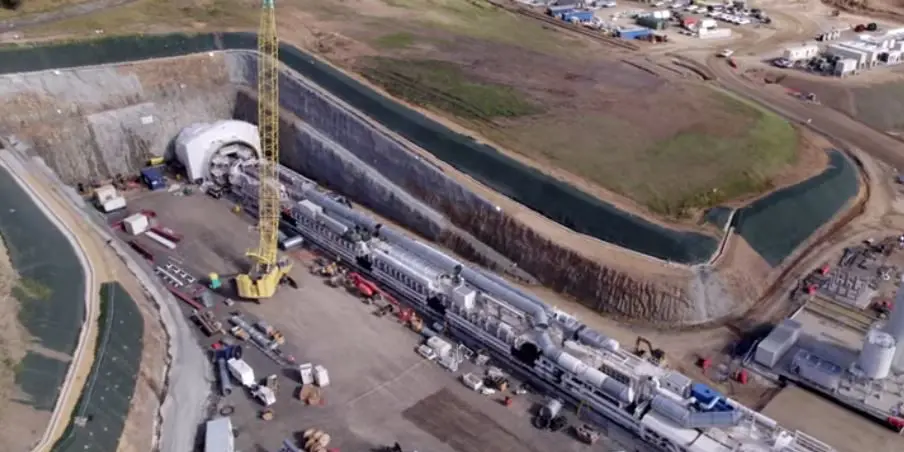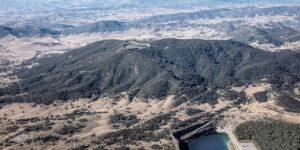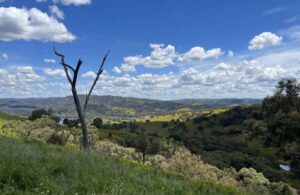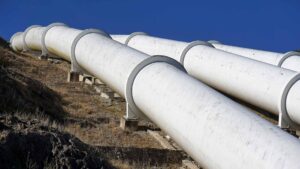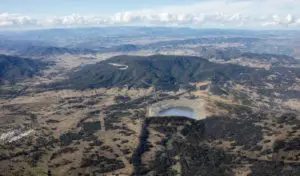The federal government owned utility Snowy Hydro has finally confirmed to the market operator what the federal energy minister has been saying for nearly a year – the estimated completion date for the massive Snowy 2.0’ pumped hydro project has been pushed out further to at least December, 2027.
The delay is confirmed in the NEM Generation Report, published by the Australian Energy Market Operator (AEMO) on January 23, 2023, wherein Snowy Hydro advises that the “full commercial use date of Snowy 2.0 has changed from Dec 2026 to Dec 2027.”
The update in the AEMO Report isn’t obvious, being mentioned in just a couple of rows of multiple spreadsheets. An extract from the 760 entries in the Change Log tab is below.

This latest delay has been expected for some time, though for a much longer period than 12 months. Last June, Clough revealed the project was 18 months behind schedule, but then recanted. Also, federal energy minister Chris Bowen was reportedly informed by Snowy Hydro of a 19-month delay till early 2028.
Despite this, AEMO kept Snowy 2.0 on its original schedule, because it had not been advised of any changes. Now, it seems, it finally has.
Snowy 2.0’s website, however, tells a different story and still states that “first power generated … is expected in 2025, followed by progressive commissioning of its six generating units.”
The last time Snowy 2.0’s completion date was publicly aired was at the November 2022 Senate Estimates. When questioned, the acting CEO declined to give an update.
Instead, he offer the somewhat feeble excuse that “until we get about 30 per cent into the [underground station] cavern, it is probably a bit premature to speculate on what overall changes in the end date will be at this point.”
When pressed, he said “my personal opinion is that the contractor, if you had to snap a chalk line at the moment, is about 12 months behind program. They are required to accelerate. We are working with the contractor to see how best that can be achieved.”
Surely, though, an official Snowy Hydro estimate of the completion date could have been provided to a government committee for a government-backed, multi-billion dollar project that has been running for six years.
When Snowy 2.0 was first announced (on 15 March 2017), the project was to be built in an unbelievably quick four years (i.e. by 2021!).
That improbably optimistic prediction was queried two months later at the May 2017 Senate Estimates and explained away by the CEO – “the four-year aim was possible only if ‘everything went your way’, with five to six years being a more likely time frame for completion [i.e. 2022 to 2023].”
Since then Snowy 2.0’s estimates have moved around a bit, but have settled back to a five to six year time frame. That is, the estimated completion is always five to six years away, and it slips back a year every year. It started as 2021 and now sits at December 2027 (almost 2028).
The diagram below demonstrates close adherence to the five to six year time frame for updates provided by Snowy Hydro, directly and via AEMO, especially in recent years. Others (e.g. Clough and Minister Bowen) provided longer and hence more realistic estimates, though also understated.
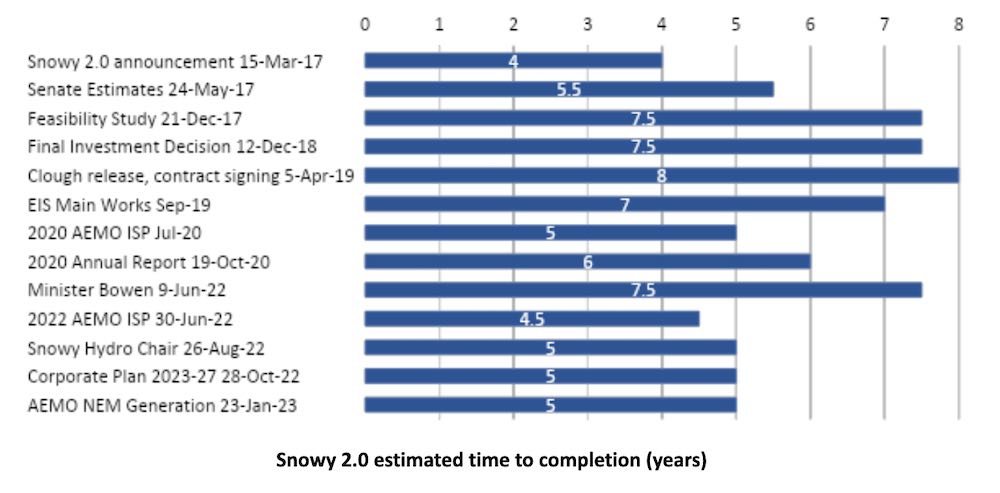
And there is no end in sight for this year-by-year slippage, given the likelihood of further problems emerging as construction ramps up over the next six or so years. Given the problematic history of the project another major delay is likely just around the corner.
What was initially supposed to be a four year project is now likely to be at least twelve. Completion this decade is looking doubtful.
Each year of delay adds hundreds of millions of dollars in construction and financing costs, and in forgone revenue.
The ‘winners’ of this never-ending project are the 2,000 strong workforce with jobs assured for years to come, international contractors (unless they go broke, as has Clough) and suppliers, the Snowy Monaro economy, and hi-vis garbed politicians filmed on regular visits.
The ‘losers’ are Australian taxpayers having to fund billions of dollars of additional Snowy 2.0 costs, Kosciuszko National Park and communities in the path of transmission connections, and the National Electricity Market not having Snowy 2.0’s storage capacity available for years after it was expected (though its claimed benefits are very much exaggerated, and its unavailability is not a big loss).
Snowy 2.0 is just not worth it and allowing the project to blunder on regardless of the consequences should not be an option. It will never pay for itself.
The debacle will continue until the federal government establishes an independent review into Snowy 2.0 and develops a strategy to get out of this mess (see here, here and here).
In the meantime, we can bank on Snowy 2.0’s five-to-six-year completion estimate continuing for years to come.
Kurri Kurri Gas Power Station now also on a yearly delay cycle
The observant among you will have seen in the above extract from AEMO’s Report that Snowy Hydro’s Kurri Kurri Gas Generator has also been delayed by a year, from Dec 2023 to Dec 2024.
That’s a one year delay just a year after the project was approved (in December 2021) – a 33% overrun so far on a supposedly two-year project.
Again, Snowy Hydro has not issued a public announcement or explanation.
And the gas station is certainly not going to be operational before Liddell Power Station is decommissioned later this year, which was the prime motivator for the previous Government to approve and pay for Kurri Kurri’s urgent construction (at a total cost now of over $1 billion when the gas lateral pipeline is included).
When will Snowy Hydro start providing fulsome information and realistic project estimates? All Australians are footing the bills.
Ted Woodley is a former managing director of GasNet, PowerNet and EnergyAustralia.

